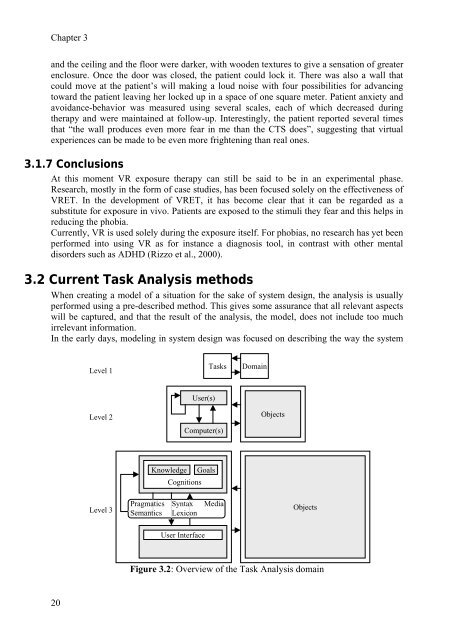Human-Computer Interaction and Presence in Virtual Reality
Human-Computer Interaction and Presence in Virtual Reality
Human-Computer Interaction and Presence in Virtual Reality
You also want an ePaper? Increase the reach of your titles
YUMPU automatically turns print PDFs into web optimized ePapers that Google loves.
Chapter 3<br />
<strong>and</strong> the ceil<strong>in</strong>g <strong>and</strong> the floor were darker, with wooden textures to give a sensation of greater<br />
enclosure. Once the door was closed, the patient could lock it. There was also a wall that<br />
could move at the patient’s will mak<strong>in</strong>g a loud noise with four possibilities for advanc<strong>in</strong>g<br />
toward the patient leav<strong>in</strong>g her locked up <strong>in</strong> a space of one square meter. Patient anxiety <strong>and</strong><br />
avoidance-behavior was measured us<strong>in</strong>g several scales, each of which decreased dur<strong>in</strong>g<br />
therapy <strong>and</strong> were ma<strong>in</strong>ta<strong>in</strong>ed at follow-up. Interest<strong>in</strong>gly, the patient reported several times<br />
that “the wall produces even more fear <strong>in</strong> me than the CTS does”, suggest<strong>in</strong>g that virtual<br />
experiences can be made to be even more frighten<strong>in</strong>g than real ones.<br />
3.1.7 Conclusions<br />
At this moment VR exposure therapy can still be said to be <strong>in</strong> an experimental phase.<br />
Research, mostly <strong>in</strong> the form of case studies, has been focused solely on the effectiveness of<br />
VRET. In the development of VRET, it has become clear that it can be regarded as a<br />
substitute for exposure <strong>in</strong> vivo. Patients are exposed to the stimuli they fear <strong>and</strong> this helps <strong>in</strong><br />
reduc<strong>in</strong>g the phobia.<br />
Currently, VR is used solely dur<strong>in</strong>g the exposure itself. For phobias, no research has yet been<br />
performed <strong>in</strong>to us<strong>in</strong>g VR as for <strong>in</strong>stance a diagnosis tool, <strong>in</strong> contrast with other mental<br />
disorders such as ADHD (Rizzo et al., 2000).<br />
3.2 Current Task Analysis methods<br />
When creat<strong>in</strong>g a model of a situation for the sake of system design, the analysis is usually<br />
performed us<strong>in</strong>g a pre-described method. This gives some assurance that all relevant aspects<br />
will be captured, <strong>and</strong> that the result of the analysis, the model, does not <strong>in</strong>clude too much<br />
irrelevant <strong>in</strong>formation.<br />
In the early days, model<strong>in</strong>g <strong>in</strong> system design was focused on describ<strong>in</strong>g the way the system<br />
20<br />
Level 1<br />
Level 2<br />
Level 3<br />
Pragmatics<br />
Semantics<br />
Knowledge<br />
User(s)<br />
<strong>Computer</strong>(s)<br />
Cognitions<br />
Syntax<br />
Lexicon<br />
User Interface<br />
Goals<br />
Tasks Doma<strong>in</strong><br />
Media<br />
Objects<br />
Objects<br />
Figure 3.2: Overview of the Task Analysis doma<strong>in</strong>
















